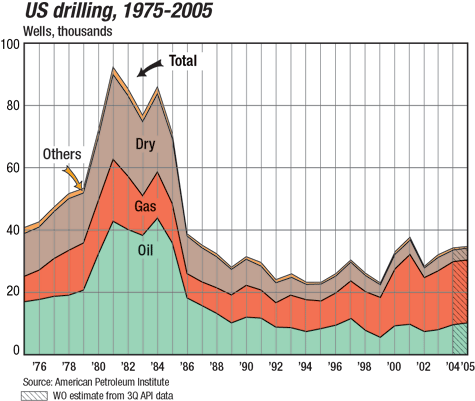OUTLOOK 2006: United States
US drilling
All we need are more rigs and crews
We haven’t seen numbers like these since 1985. Remember the bumper sticker? “Please God, just give us one more boom, we promise we won’t (!*&^#) it up this time.” Well, so much for promises. There remains no sign that the party is over but from these lofty heights, some sort of plateau, if not a summit, cannot be too far off.
We should add another 4,400 wells in 2006, bringing the total to 45,604, a 10.7% increase over 2005. This year we forecast yet another strong increase, yielding steady, three-year growth.
It’s often said that history comes full circle to repeat itself, but history is really more like a spiral, and there are important differences this time around compared to the last boom. For one thing, exploration drilling is not increasing much, and it may have finally flattened out or ticked up after the past four-year downtrend. Geopolitically, things are much more iffy than in the early 1980s. Oil was king, while gas was out of favor – a situation that has been exactly reversed. And there wasn’t a boom in so-called continuous plays back then. These are the tight sands, coalbeds and shales that extend for hundreds of miles and are the new source for natural gas. Clearly, the boom would be much less if not for these.
One year ago, World Oil’s forecast for 2005 was just shy of 40,000 wells. We made a midyear correction to 41,517 wells, which was just 328 wells over what state agencies now say are the actual numbers.
World Oil’s forecast for 2006 includes:
- For the US, 45,604 wells are expected, a 10.7% increase.
- The US rig count will average 1,548 during 2006, up 12%.
- Gulf of Mexico drilling will rise 4.1% to 931 wells.
- Unconventional gas drilling will continue to rise in importance.
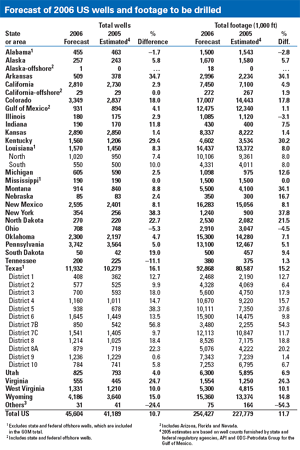 |
| |
Forecast of 2006 US wells and footage to be drilled
Click image for enlarged view |
|
|
|
Prices. Prices are forecast to remain high by nearly everyone, which is the only negative on that front. No one knows what world demand will be, but if it’s like last year, IEA will revise it up and down often. There are indications that demand destruction occurs at around $3 a gallon for gasoline, and a slight decrease in US demand and oil prices, especially in the wake of Hurricanes Katrina and Rita, kept inventories at normal levels. Gas, however, spiked, and has yet to come down to pre-hurricane levels. Expect the damage in the Gulf of Mexico to keep some oil and gas production (a slowly improving, 20% component of Gulf production) offline through most of 2006, which will keep an upward pressure on prices.
Last year, the forecast was for an average price of $49/bbl. The actual average price was $56.64. This year, World Oil forecasts an average oil price of $57/bbl.
Natural gas will remain the main driver of the US E&P industry this year, accounting for more than 80% of all drilling. World Oil forecasts an average wellhead gas price of $8.50/Mcf for this year. Last year, it averaged $7.53.
Operator surveys. World Oil’s year-end survey of 18 US major drillers (integrated companies and independents with large drilling programs) and 130 independents showed that they are optimistic, probably too much in light of the difficulty finding crews and rigs for the 19% increase that the surveys indicate. We see some of the state agency opinions, although based on permit activity and local knowledge, also as too optimistic.
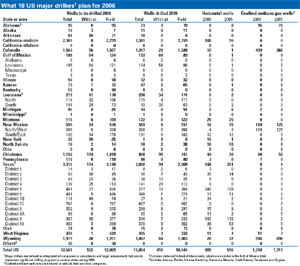 |
| |
What 18 US major drillers plan for 2006
Click image for enlarged view |
|
|
|
The survey of independents indicated that they will be up 27%, while the majors’ survey shows they will drill 16% more this year. To illustrate the effect that unconventional drilling is having, of the 2,545-well increase that the surveys, taken together, indicate, 21% (546 wells) are coalbed. This number would be much higher, perhaps double, if we knew the number of other unconventional gas wells to be drilled. It’s worth noting that, while the size of the sample is robust, these are not scientific surveys.
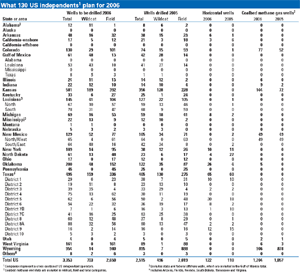 |
| |
What 130 US independents plan for 2006
Click image for enlarged view |
|
|
|
Although Citigroup is forecasting spending to increase 16.5% in the US, it’s important to realize that a substantial part of that will go into increased costs as a result of the boom, such as increases in day rates, tubulars and services.
Rigs. Rigs are being scrounged and built from scavenged parts, as well as some newbuilds and a few bought from foreign sources, such as Italy’s Drillmec. There are signs that rig efficiency is falling slightly. The Baker Hughes rig count rose 16% in 2005, about the same as the previous year, but drilling rose at a slower rate. We could not find evidence nationwide that the average drilling depth was increasing much, so it may be that either less experienced crews, older, less efficient rigs, more difficult wells, or some combination of these is responsible for the lower rig efficiency. In terms of trends, the average BHI yearly rig count over the past five years (2001 – 2005) has been 1,156, 830, 1,032, 1,192, and 1,383, with the corresponding year-to-year percentage changes being – 28.2%, 24.3%, 15.5%, 16.1%. For this year, we think that the BHI rig count will rise to 1,548, a 166-rig increase.
Area highlights. Twelve states will see double-digit percentage increases. Texas will see the largest increase in wells drilled this year, at 1,653 wells. Reserves in that state might actually increase again, as they did in 2004, albeit just a little. Still, usually, the state loses reserves. According to the Texas Alliance of Energy Producers, drilling permits were up 16% last year, to 15,501, and Texas oilfield employment added 4,700 jobs (3%) and now stands at 144,700.
Wyoming will be the second largest borehole maker, drilling 546 more wells this year, followed by Colorado, with 512, and Kentucky, at 354 wells.
Although there are some signs that coalbed drilling may be leveling off, our operator surveys do not show that to be the case. In any case, it would be at a high level and could easily go higher. The 2005 well numbers include 5,572 coalbed methane wells, and 11,197 permits. Wyoming alone drilled 2,700 CBM wells last year, and the state foresees 3,500 more wells this year. Under the state’s current Environmental Impact Statement, it is allowed to drill up to 50,000 CBM wells, which leaves room for at least 35,000 more in coming years. However, a federal judge ruled last month that a Clean Water Act permit for coalbed methane operations in Wyoming is illegal due to procedures in the permitting process. So, the environmental battles continue.
Virginia expanded its coalbed play with 400 wells, as did Colorado. A number of states have begun small experiments in the past two years. Meanwhile, although we do not have separate state and local statistics on other forms of unconventional plays, the Barnett Shale in northern Texas, and two new plays, the Mississippian Caney Shale in Oklahoma, and the Fayetteville Shale in Arkansas are growing rapidly. They both resemble the Barnett, which seems to have no bounds.
To the north in Williston basin, which straddles North Dakota and Montana, a new play is being drilled in the Bakken Dolomite, including many horizontal development wells. The formation is tight, as many dolomites are, with low permeability, and requires extensive fracturing. The play is reported to have a potential resource of 400,000 barrels of oil equivalent recoverable per 640 acres. Taken together, the two states added 239 wells in 2005, some 29% more than the previous year, and plan to add another 124 wells (12%) this year.
California is planning an expansion on northern coast offshore leases. Environmental interests are fighting the move with a proposal to widen adjacent environmentally restrictive areas that prohibit drilling.
In the East, the well-known Antrim and the Ohio Shales continue to get developed, while Kentucky is drilling a new Albany Shale play in the Devonian. Kentucky has nearly tripled the number of wells drilled in the past three years. This shale play seems to have no bounds, with a 99% success rate. Some of the wells there appear to be inexhaustible, having produced for decades at plateaus or even increasing rates. The deep Trenton/ Black River is a play that extends through parts of New York, West Virginia, Ohio, Kentucky, Tennessee and Pennsylvania. Some of these wells are over 15,000 ft deep and 400°F.
In the Gulf of Mexico, the effects of the past two hurricane seasons will slowly fade, but it will take much of this year to get back to normal. Even then, there will be a lingering pipeline or repair that still needs to be fixed. We think that drilling will rise 4.1% to 931 wells, depending, of course, on how the hurricane season goes.
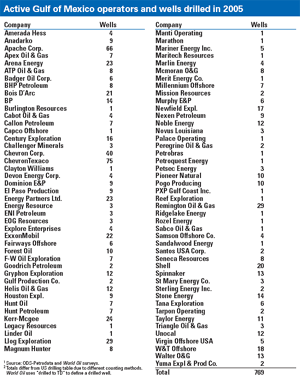 |
| |
Active Gulf of Mexico operators and wells drilled in 2005
Click image for enlarged view |
|
|
|
About these statistics.World Oil’s tables are produced using the aid of data from a variety of sources, including the American Petroleum Institute, ODS-Petrodata Group, the Texas Railroad Commission and other state and federal regulatory agencies and international regulatory agencies. In addition, 148 operating companies with drilling programs responded to this year’s survey. Please note credits and explanations in table footnotes.
World Oil editors try to be as objective as possible in this estimating process to present what they believe are the most current data available. It is realized that sound forecasting can only be as reliable as the base data. In this respect, it should be noted that well counting is a dynamic process, and most historical data will be continually updated over a period of several years before the “books are closed” on any given year. 
|

